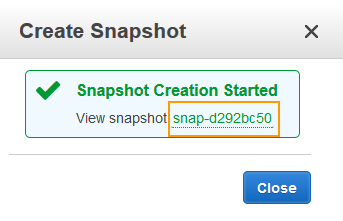Step 1: Note the Barracuda Load Balancer ADC Information
- Log into the AWS EC2 Management Console.
- From the EC2 dashboard, scroll to INSTANCES and select Instance.
- In the Instances table, select the Barracuda Load Balancer ADC requiring an increased disk size and note the following:
- Instance ID
- Availability Zone
- EBS ID by clicking on the Root device value.
Step 2: Shutdown the Barracuda Load Balancer ADC Instance
- If the Barracuda Load Balancer ADC is still running, go to the web user interface.
- Navigate to the BASIC > Administration page, go to the System Reload/Shutdown section, and click Shutdown.
Step 3: Note the Disk Size and Create a Snapshot of the Volume
- From the EC2 dashboard, scroll to ELASTIC BLOCK STORE and select Volumes.
- In the search filter, enter the EBS ID noted in step 3.c under Step 1: Note the Barracuda Load Balancer ADC Information.
- Note the current disk size listed next to Size.
- Right click on the volume, and select Create Snapshot.
- In the Create Snapshot window, enter a name and description, and click Create.

- Note the snapshot ID.

Step 4: Create a New Volume for the Snapshot
- From the EC2 dashboard, select Snapshots under ELASTIC BLOCK STORE.
- In the search filter, enter the snapshot ID noted in step 5 under Step.2: Create a Snapshot of the Volume.
- Right click on the snapshot when Status displays completed, and click Create Volume.
- In the Create Volume window, do the following:
- Select the desired volume type.
- Enter a new volume size.
- Ensure the Availability Zone matches the instance Availability Zone noted in step 3.b under Step 1: Note the disk size of the Barracuda Load Balancer ADC and stop the instance.
- Click Create.

- Note the volume ID.

Step 5: Detach the Old Volume from the Instance
- From the EC2 dashboard, select Volumes under ELASTIC BLOCK STORE.
- In the search filter, enter the EBS ID noted in step 3.c under Step 1: Note the disk size of the Barracuda Load Balancer ADC and stop the instance.
- Right click on the volume, and select Detach Volume.

- In the Detach Volume window, click Yes, Detach to confirm.
Step 6: Attach the New Volume to the Instance
- From the EC2 dashboard, select Volumes under ELASTIC BLOCK STORE.
- In the search filter, enter the volume ID noted in step d under Step.3: Create a New Volume for the Snapshot.
- Right click on the volume, and select Attach Volume.
- In the Attach Volume window, complete the following:
- Enter the name or instance ID in the Instance field, and select the instance noted in step 3.a under Step 1: Note the disk size of the Barracuda Load Balancer ADC and stop the instance.
- Ensure the device name is /dev/xvda.
- Click Attach.

Step 7: Restart the Instance to Apply the New Volume
- From the EC2 dashboard, select Instance under INSTANCES.
- In the Instances table, select the Barracuda Load Balancer ADC instance to which the new volume was attached in step 4 under Step.5: Attach the New Volume to the Instance .
- Right click on the instance, select Instance State and then select Start.
- In the Start Instances window, choose Yes, Start. If the instance fails to start and this is a root volume, verify that you attached the expanded volume using the same device name as the original volume, for example /dev/xvda.
